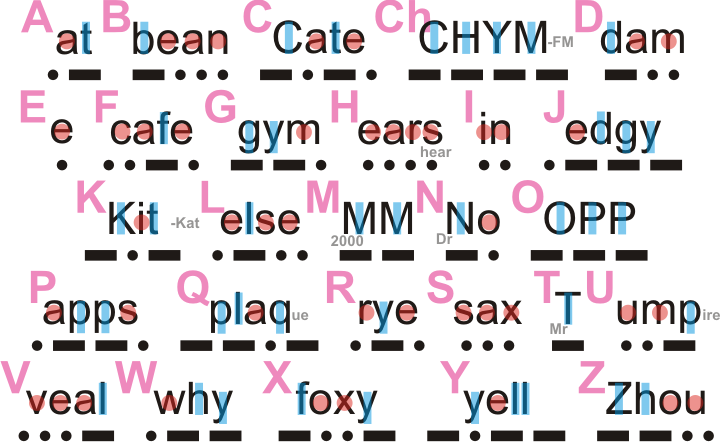Learning Morse Code
by siteadmin

Learning Morse code is an important skill for ham radio operators. It can help you stay in touch in times when cell phone signals aren’t reliable.
Morse code uses combinations of dots and dashes to represent letters, numerals, and punctuation symbols. It also employs standard rules for timing gaps between characters.
It’s an important part of Ham Radio
Morse Code is an important part of Ham Radio because it allows operators to communicate with one another using minimal power and bandwidth. Additionally, it can be used to communicate emergency messages and distress signals. Additionally, learning Morse Code can provide a sense of personal accomplishment. It is also an interesting skill to have in the event of a disaster or other emergency.
One of the best ways to learn Morse Code is to use a software program that will allow you to hear it audibly. There are many programs available for iPads, Macs and PC’s. You can also practice with local Morse code beacons run by amateur radio clubs. These resources will help you get the feel for the dot and dash timing and will make it easier to decipher audio communications.
Another way to practice is to write the letters of the alphabet on a piece of paper with a writing utensil. This can be challenging, but it will help you get the hang of the dot and dash pattern and will help you to learn faster. You can also try to spell out simple words with the dots and dashes. This will force you to think a little differently and will help you get your timing down.
If you want to learn more about Morse Code, consider joining a local amateur radio club. These groups will often have CW mentors who can teach you the basics and offer advice on how to improve your skills. You can also find many online resources that will teach you the basics of CW.
Whether you’re a seasoned ham or just getting started, learning Morse Code is an important part of the hobby. It’s easy to learn and a great way to have fun. Just be sure to practice often! Also, don’t forget that if you don’t use it, you lose it. Those who never practice their CW will eventually forget it completely. So, turn off the social media and practice your CW! You’ll be glad you did.
It’s easy
Learning Morse Code is an easy and rewarding experience. Whether you’re an amateur radio operator or just want to be prepared in the event of emergencies, Morse code is a useful skill to acquire. There are many resources available online and in mobile apps that make it simple to learn the signals and alphabet. Many of these resources are free and offer a fun, entertaining way to practice your new skills.
One popular resource is LICW, which offers free practice for both encoding and decoding text and words. The site tracks your progress and provides helpful feedback. It also allows you to set your own pace. Once you’re comfortable with a certain letter, the website will add more letters to your practice. This way, you’ll never be overwhelmed with sounds you can’t handle.
Another option for learning Morse is to use a phone app that can convert your voice into Morse. This is especially helpful if you don’t have access to a computer. Many of these apps allow you to select the letters that you are most comfortable with and will automatically translate them into Morse for you. You can even select the speed of your voice so you can practice encoding and decoding at different speeds.
You can also learn Morse through classes offered by the Long Island CW Club. These courses are designed for school-age children and are held online via Zoom. The courses are led by licensed ham operators and will help students become familiar with the code’s signaling, alphabet, and symbols. In addition, they will learn how to operate a radio and understand Amateur Radio terms.
Learning Morse code can be difficult for some, but it’s important to take it slowly. Start by learning a few letters at a time and practice regularly. It’s also a good idea to set aside dedicated practice time each day. This will ensure that you progress quickly and will be able to communicate with fellow hams in emergency situations. You can also download a Morse code keyboard on your phone to help you with your learning.
It’s fun
Morse code can be a fun hobby, especially when you have the right tools. Many people learn Morse code using a software program on their computer or tablet, and there are even radio beacons operated by local amateur radio clubs that you can practice receiving off the air. Many people also learn Morse by listening to other people use it. This is an effective way to learn the code because you can hear how it sounds, and you’ll have a good sense of what it means to be able to send and receive messages.
The best way to learn Morse code is to listen to it and compare it with a written version of the alphabet. Many people have difficulty with learning Morse because of the repetition and the fact that it’s not a visual language, but if you listen to it long enough, it will become second-nature. Once you’ve mastered the letters, try to listen to a message at a realistic speed.
Some people use visual mnemonic charts to memorize the symbols, and this is a great way to help kids learn the code. This method is not always successful, however, because it can be easy to forget which sequences are letters and which are numbers. This can make it difficult to decipher a coded message in an emergency situation.
Other people prefer to write out the sequences for each letter on a piece of paper and then attempt to copy them without any assistance. This is a good way to test your skills, but it’s not always very helpful if you forget a sequence and are unable to recall the correct one.
Keeping a journal in Morse is another fun way to learn the language. You can use it to record your grocery list, notes to loved ones, haikus, and other short messages. This is a great way to incorporate the new language into your everyday life, and it can be a lot of fun for you and those around you. The more you practice, the faster you’ll be able to read and write in Morse.
It’s useful
As a means of communication, Morse code has long been useful for people around the world. Originally developed for telegraph machines, it later enabled people to communicate with each other via radio. It can also be used in other ways, such as light signals and aural messages. The basic rules of the code are easy to learn. All you need to know is the sequence of dots and dashes that represent letters, numbers and punctuation, as well as the timing rules of the code.
Unlike voice communication, Morse code cannot convey emotion or tone. However, it is still useful for delivering information quickly and reliably, even in times of emergencies or disasters. For example, during the pandemic lockdown in 2017, amateur radio operators were able to keep in touch with each other through Morse code. In addition to being a form of social media, this communication was critical for rescue workers and others working outside.
When learning Morse code, it is important to practice with a specialized program that will help you master the basics of the language. Some programs use a combination of visual recognition and audio recordings to make the learning process more efficient and effective. In addition, they include a haptic feedback system that replicates the feel of tapping out a message on a keyboard. This can help you understand the meaning of a word as you tap it out, making it easier to remember and repeat.
Some programs also change the timing rules so that there are two different speeds of code: character and text. For example, a person may learn to copy individual characters at a rate of 13 words per minute, while the gaps between each letter or word are longer. This is known as the Farnsworth method of teaching Morse code.
Another useful strategy for gaining proficiency is to read children’s books that contain terse language. These books provide a great way to practice your speed and comprehension as you read them page by page. You can also purchase practice recordings to receive instruction that is tailored to your comprehension level. These recordings can be a valuable resource for those who are new to the Morse code language.
Learning Morse code is an important skill for ham radio operators. It can help you stay in touch in times when cell phone signals aren’t reliable. Morse code uses combinations of dots and dashes to represent letters, numerals, and punctuation symbols. It also employs standard rules for timing gaps between characters. It’s an important part…
Recent Posts
- Revolutionizing Real Estate Investment: Exploring the Promise of Robinhood Real Estate Investments
- Expert Cleaners Lexington: Setting New Standards in Quality Assurance and Flexibility
- Expert Cleaners Lexington: Setting New Standards in Quality Assurance and Flexibility
- Understanding the Science Behind Lip Fillers: How Do They Work?
- The Hydro Jetting Advantage: Why It’s Essential for Houston Properties
